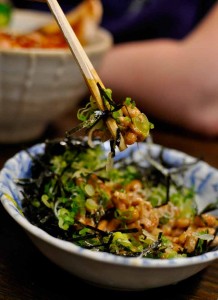Soybeans present unlikely mélange of dishes
Is there a legume more controversial than the soybean? It’s been accused of being Monsanto’s evil, earth-killing, bio-tech child, an allergy trigger, an impediment to proper development in infants, a duplicitous pouch of carcinogens and an emasculating testosterone leech.

Japanese treat · For those squeamish about stinky, exotic dishes, Japanese natto provides a more subtle soybean experience. - Sophia Lee | Daily Trojan
At the same time, soybeans are lauded as key to the longevity and slim characteristic of Asian cultures. Nutritionists claim soybeans are a perfect protein and calcium source, which at least partially explains why soybean products such as tofu and soymilk have infiltrated the United States’ markets with lofty nutritional claims of being healthier alternatives to meat and dairy.
These opposing allegations might draw never-ending debates, but, love them or hate them, soybeans are familiar commodities. Once considered a foreign ingredient of the exotic East, soy appears in just about any food now, from milk and cheese to bacon and Tofurky, even ice-cream and cupcakes. Most famously, soybeans are synonymous with tofu.
Maybe that’s why soy still connotes a substitute. It’s a tasteless, funky hippie fare, or the second-best option to the “real thing.”
Let’s get the truth out of the way first: Tofu is bland. It’s a pale, spongy chunk of gunk sitting in liquid in a plastic container. Tofu is a product of soybeans, and it’s usually eaten as a filler to meat, unlike the western tendency to eat it as a vegetarian substitute.
Elsewhere in the world, soybeans are enjoyed as intriguing fermented dishes, bursting with flavor and curious odors that haven’t taken global stage because they require a lot more bravado and a highly resistant nose.
The Korean stew cheonggukjang, the badass of miso soups, is one example.
Cheonggukjang is an earthy-red stew made from boiled soybeans left in warmth for days, interacting with air and bacteria until it gets digested into a pouch of nose-crushing stenches. The fermented soybean paste is simmered in broth, and chunks of tofu, onions and chili are added for extra heft.
As revolting as it sounds, this hearty Korean goulash is beloved by Koreans as a nutrient-rich “well-being” food. In Koreatown, lines are out the door even on a weekday afternoon at Olympic Cheonggukjang, one of Los Angeles’ most popular places for this stew. Walk barely past the door and you’ll realize you’ve walked into a stink dungeon, but you’ll also be greeted by enthusiastic customers digging into the thick flavorful sludge and an array of other stinky fermented side dishes like kimchi.
Originally, soybeans were consumed only after decomposition, as raw soybeans are toxic to humans. Fermentation helped to break down some of the indigestible sugars and acids.
Yes, fermentation stinks. But the process also builds up many flavors — complex dimensions of tastes and odors that smack full of umami, the inexplicable savory fifth taste sense that intimates comfort and satisfaction.
If you’re still squeamish about the pungent smell, start with the Japanese natto, whole soybeans fermented with specific bacteria until slimy and gooey. Natto is typically served for breakfast, either on top of steamed rice or as a side dish, with a dollop of soy sauce and mustard or stirred with raw egg and scallions.
Its nutty, salty flavor isn’t as intense as the Korean stew’s; it’s the viscous texture that gets you. As you pull apart a bean with your chopsticks, you’ll see a sticky, syrupy substance that’s pulled apart from the rest of the pile — that’s the fermentation.
Most home-style Japanese restaurants and Japanese markets in Los Angeles offer natto. Fukugawa in Gardena serves traditional Japanese breakfast sets that include natto, rice, grilled fish, tamagoyaki (rolled sweet omelet) and miso soup. Some places, such as Mid-city’s Sushi Roku and Sake House Miro, also sneak natto into an innocent sushi roll.
Sushi rolls aren’t the only fun way to eat soybeans though. Having tofu deep-fried is another option; just about anything in the world tastes fabulous when dunked in sizzling oil and fried to a crisp. “Chou doufu” (literally, “stinky tofu”) is a popular delicacy in Taiwan, where stalls line up in night markets and stink up the whole area with the tofu’s pungent smells.
Lee’s Garden in Alhambra is a good place to acquaint yourself with stinky tofu that is authentic but sensibly tamer than the street version. The stench, more like a whiff than a wallop, isn’t as powerful. If you can get past the smell, stinky tofu is actually quite pleasant with its crispy, golden exterior and spongy, custardy insides. The taste is surprisingly mellow and reminiscent of tangy low-fat cream cheese.
If you’ve built up your tolerance and want something more potent, try the hotpot version of stinky tofu. 101 Hot Pot Café in San Gabriel Valley has a decent hot pot stinky tofu — as good as a hellish, fermented brew can get, anyway. There’s no guarantee you’ll enjoy it, but there’s no question the stink and taste will stay etched in your mind for a long time.
Sophia Lee is a junior majoring in print and digital journalism and East Asian languages and cultures. Her column “Cross Bites” runs Mondays.

No reason for debating the health benefits of soy. Stick with non-GMO products and you have thousands of years of use on your side. If that is not enough, you can look into the scientific research surrounding soy and you will find proof that soy will not make men grow breasts or cause cancer. However. if you are lazy in your research you will most likely find the pseudo research propagated by the Weston Price Foundation, a group funded by the dairy industry. Hmmm, I wonder why their research says so is bad….follow the money and look for real science. Do not just take the top hit.